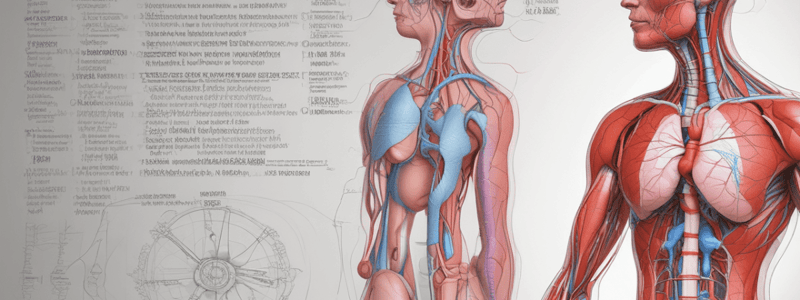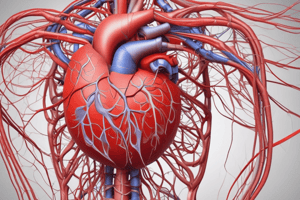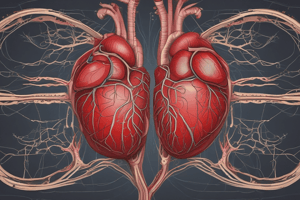Podcast
Questions and Answers
What is the location of the apex of the heart?
What is the location of the apex of the heart?
- Just above the diaphragm, left of the midline (correct)
- In the center of the chest, anterior to the spine
- Just below the diaphragm, right of the midline
- At approximately the level of the second rib
What is the main function of the specialized structures in myocardium cells?
What is the main function of the specialized structures in myocardium cells?
- To increase the amount of blood pumped by the heart
- To enable the heart to contract (correct)
- To increase the thickness of the myocardium
- To regulate the heart rate
What is the approximate size of the heart?
What is the approximate size of the heart?
- The size of an adult's open hand
- The size of an adult's head
- The size of an adult's foot
- The size of an adult's closed fist (correct)
What is the name of the innermost layer of the heart?
What is the name of the innermost layer of the heart?
What is the significance of the myocardium cells' electrical properties?
What is the significance of the myocardium cells' electrical properties?
What is the location of the base of the heart?
What is the location of the base of the heart?
What is the proportion of the heart's mass to the left of the midline?
What is the proportion of the heart's mass to the left of the midline?
What is the name of the outermost layer of the heart?
What is the name of the outermost layer of the heart?
What is the significance of the heart's location in the mediastinum?
What is the significance of the heart's location in the mediastinum?
What is the function of the great vessels in relation to the heart?
What is the function of the great vessels in relation to the heart?
What is the primary function of the pericardial fluid in the pericardial cavity?
What is the primary function of the pericardial fluid in the pericardial cavity?
What is the name of the valve that separates the right ventricle from the pulmonary artery?
What is the name of the valve that separates the right ventricle from the pulmonary artery?
Which vessels carry oxygenated blood from the lungs to the left atrium?
Which vessels carry oxygenated blood from the lungs to the left atrium?
What is the term for the specialized fibers that connect the valve leaflets to the papillary muscles?
What is the term for the specialized fibers that connect the valve leaflets to the papillary muscles?
What is the purpose of the interatrial and interventricular septa?
What is the purpose of the interatrial and interventricular septa?
Which part of the aorta goes through the diaphragm and enters the abdomen?
Which part of the aorta goes through the diaphragm and enters the abdomen?
What is the term for the inner layer of the pericardium that is in contact with the heart muscle?
What is the term for the inner layer of the pericardium that is in contact with the heart muscle?
What is the reason for the left myocardium being thicker than the right?
What is the reason for the left myocardium being thicker than the right?
What is the source of nutrients for the heart muscle?
What is the source of nutrients for the heart muscle?
What is the purpose of the papillary muscles in the ventricles?
What is the purpose of the papillary muscles in the ventricles?
What is the direction of perfusion in the heart?
What is the direction of perfusion in the heart?
Which branch of the left coronary artery supplies the heart’s lower conduction system?
Which branch of the left coronary artery supplies the heart’s lower conduction system?
What is the function of the coronary vessels during diastole?
What is the function of the coronary vessels during diastole?
What is the purpose of collateral circulation in the heart?
What is the purpose of collateral circulation in the heart?
What is the primary function of the tunica media in arteries and veins?
What is the primary function of the tunica media in arteries and veins?
What is the relationship between the diameter of a vessel and the amount of blood it can transport?
What is the relationship between the diameter of a vessel and the amount of blood it can transport?
What is the primary function of the arterioles in the arterial system?
What is the primary function of the arterioles in the arterial system?
What is the purpose of the capillary walls in the vascular system?
What is the purpose of the capillary walls in the vascular system?
What is the direction of blood flow in the venous system?
What is the direction of blood flow in the venous system?
What is the difference between the tunica media in arteries and veins?
What is the difference between the tunica media in arteries and veins?





